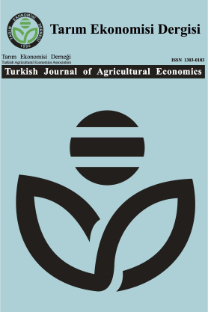Arıcılık İşletmelerinde Arıcı Sağlığı Riski İle Diğer Bazı Risk Faktörlerinin İncelenmesi “İzmir Örneği-Türkiye’’
Arıcı, sağlık, riskler, sosyal güvenlik, arı ürünleri, güvenlik standartları
An Evaluation on Beekeepers' Health and Some Risk Factors in Beekeeping Farms: "A Case of Izmir-Turkey"
Beekeeper, health, risks, social security, bee production, safety standards,
___
- Adams, E. C., 2018. How to become a beekeeper: learning and skill in managing honeybees. Cultural geographies, 25(1), p31-47.Aiyeloja, A. A., Adedeji, G. A., & Emerhi, E. A., 2015. Impacts of bee hive stands’ heights and hives’ types on the ergonomics of honey harvesting in Port Harcourt, Nigeria. N Y Sci. J., 8(4), p23-27. (ISSN: 1554-0200).Annila, I. T., Karjalainen, E. S., Annila, P. A., & Kuusisto, P. A., 1996. Bee and wasp sting reactions in current beekeepers. Annals of Allergy, Asthma&Immunology, 77(5), p423-427.Annila, I. T., Annila, P. A., & Mörsky, P., 1997. Risk assessment in determining systemic reactivity to honeybee stings in beekeepers. Annals of Allergy, Asthma & Immunology, 78(5), p473-477.Basista, K. M., & Filipek, B., 2012. Allergy to propolis in Polish beekeepers. Advances in Dermatology & Allergology/Postepy Dermatologii i Alergologii, 29(6), p440-445.Basista-Sołtys, K., 2013. Allergy to Propolis in Beekeepers- A Literature Review. Occup Med Health Aff, 1(105), p2.Becerril-Ángeles, M., Núñez-Velázquez, M., Grupo, D. P. D. C. D., & la Abeja, A., 2012. Risk Factors for Allergy to Honey-bee Venom in Mexican Beekeepers. Revista alergia Mexico (Tecamachalco, Puebla, Mexico: 1993), 60(3), p100-104.Çelik, Y.,Turhan, İ., 2014. Konya İlinde Arıcılık İşletmelerinin Yapısal Özellikleri. U. Arı Drg. Mayıs, 14 (1), p15-25.Çelikel, S., Karakaya, G., Yurtsever, N., Sorkun, K., & Kalyoncu, A. F., 2006. Bee and bee products allergy in Turkish beekeepers: determination of risk factors for systemic reactions. Allergologia et immunopathologia, 34(5), p180-184.Çeliksoy, M. H., Sancak, R., Söğüt, A., Güner, Ş. N., Korkmaz, A., 2014. Characteristics of venom allergic reactions in Turkish beekeepers and alternative treatment modalities. In International forum of allergy & rhinology (Vol. 4, No. 7, pp. 555-558).Donham, K. J., & Thelin, A., 2006. Agricultural medicine: occupational and environmental health for the health professions. Black well Pub.Günbey, V. S. 2007. Van ili gezginci arıcılık hareketlerinin belirlenmesi. Yüzüncü Yıl University Institute of Natural and Applied Sciences. Master's Thesis. p:61.Kaya, F. 2008. Ağrı İlinde Arıcılık Yapısı Ve Değerlendirme Durumu. Atatürk Üniversitesi Sosyal Bilimler Enstitüsü Dergisi, 12(2).Kovats, R. S., & Hajat, S., 2008. Heat stress and public health: a critical review. Annu. Rev. Public Health, 29, p41-55.Light, W. C., Reisman, R. E., Wypych, J. I., & Arbesman, C. E., 1975. Clinical and immunological studies of beekeepers. Clinical & Experimental Allergy, 5(4), p389-395.Maina, G., Rossi, F., & Baracco., A., 2016. How to Assess the Biomechanical Risk Levels in Beekeeping, Journal of Agromedicine, 21(2), p209-214, DOI:10.1080/1059924X.2016.1141132McMichael, A. J., Woodruff, R. E., & Hales, S., 2006. Climate change and human health: present and future risks. The Lancet, 367(9513), p859-869.Münstedt, K., Hellner, M., Hackethal, A., Winter, D., & Von Georgi, R., 2007. Contact allergy to propolis in beekeepers. Allergologia et immunopathologia, 35(3), p95-100.Münstedt, K., Hellner, M., Winter, D., & Von Georgi, R. 2008. Allergy to bee venom in beekeepers in Germany. Journal of Investigational Allergology and Clinical Immunology, 18(2), p100.Münstedt, K., & Thienel, J., 2012. Beekeepers in central Europe are at high risk for contracting Lyme borreliosis. Journal of Apicultural Research, 51(4), p291-297.Nazik, H., Turhan, M., Koca, T. T., Mülayim, M. K., Öztürk, P., & Nazik, S., 2018. Arıcılarda Arı Ürünlerine Maruziyet ile Allerji, İnflamasyon ve Enfeksiyon İlişkili Durumların Araştırılması. Kahramanmaraş Sütçü İmam Üniversitesi Tıp Fakültesi Dergisi, 13(2), p34-37.Nettleingham J, White B., 2008. Beekeeping Certificate III, Participants Learning Guide, RTE3713A Carry out workplace OHS procedures. Australian Honey Bee Industry Council: 4-18, Available at: https://www.honeybee.org.au/pdf/RTE3713A.pdf Accessed: 01.07.2019. Newbold, P. 1995. Statistics for Business and Economics, Prentice Hall International Editions.Özer, E. 2017. Kütahya İlinde Arıcılığın Yapısal Analizi, Arıcı Sağlığı, Güvenliği, Sorunları Ve Çözüm Önerileri. Uşak Üniversitesi Fen Bilimleri Enstitüsü Yüksek Lisans Tezi. 85 sayfa. Uşak.Pastorello, E. A., Incorvaia, C., Sarassi, A., Qualizza, R., Bigi, A., & Farioli, L., 1987. Epidemiological and clinical study on bee venom allergy among beekeepers. Bollettinodell'Istitutosiero terapicomilanese, 67(5-6), p386-392.Popescu, C. R. G., & Popescu, G. N., 2019. The Social, Economic, and Environmental Impact of Ecological Beekeeping in Romania. In Agrifood Economics and Sustainable Development in Contemporary Society (pp. 75-96). IGI Global.Richter, A. G., Nightingale, P., Huissoon, A. P., & Krishna, M. T., 2011. Risk factors for systemic reactions to bee venom in British beekeepers. Annals of Allergy, Asthma & Immunology, 106(2), p159-163.Stanhope, J., Carver, S., & Weinstein, P., 2017. Health outcomes of beekeeping: a systematic review. Journal of Apicultural Research, 56(2), p100-111.Topal, E., Atayoğlu, T A., Kösoğlu, M., & Atayoğlu, G. A., 2016. Arıcılıkta İş Sağlığı ve Güvenliği Risk Faktörleri. 8th International Congress on Occupational Health and Safety. p:458, Istanbul, 8-11 May.TURKSTAT 2017. Beekeeping Statistics, Ankara.
- ISSN: 1303-0183
- Yayın Aralığı: 2
- Başlangıç: 1992
- Yayıncı: Tarım Ekonomisi Dergisi
Su Kaynaklarının Korunmasında Yerel Tohum Çeşitlerinin Rolü Üzerine Çiftçi Görüşleri
H.Ece SALALI, Ela ATIŞ, Cihat GÜNDEN
Tarım 4.0 ve Türkiye'de Uygulanabilirliğinin Değerlendirilmesi
Şule ERCAN, Ruken ÖZTEP, Duran GÜLER, Gamze SANER
Gıda İsrafının Belirlenmesi: Aydın İli Örneği
Ayşe ÜNDEVLİ, Gamze KADAM, Yüksel Leyla BEKDİK, Halil İbrahim YILMAZ, Ferit ÇOBANOĞLU
Afganistan Tarım Ürünleri Dış Ticaret Yapısına İlişkin Bir Değerlendirme
Mohammad Sharf RAHİMİ, M. Metin ARTUKOĞLU
Tarife Dışı Engellerin Türkiye’nin Tarım Ürünleri Dış Ticaretine Olan Etkisi
Osman Orkan ÖZER, Betül GÜRER, Berrin TAŞKAYA TOP, Mustafa KAN
Türkiye’de Çok Boyutlu Kırsal Yoksulluk
Burak ÖZTORNACI, Haydar ŞENGÜL
Zeytinyağ Sektöründe Çapraz Ülke Etkinliği: İtalya-Türkiye
Altuğ ÖZDEN, Maurzo PROSPERI, Rafaela DIOS-PALOMARES, Armando URSITTI
Erkan TOPAL, Gamze SANER, Banu YÜCEL, Mirela STRANT, Engin ÜÇEŞ, Tuğçe OLGUN, Zekiye ŞENGÜL
Türkiye’de Son Yıllarda Gübrede Uygulanan Politikalara Genel Bir Bakış
